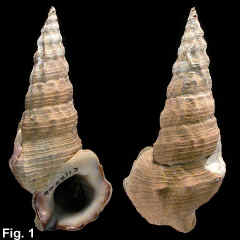|
|
BATILLARIIDAE |
|
|
|
Pyrazus ebeninus (Bruguiere, 1792) Description: Shell solid and heavy; sculptured with axial ribs that usually extend from suture to suture on spire whorls, contracting on last two whorls to a row of pointed nodules at centre of whorl; spiral sculpture of about 10 ribs overlays axial sculpture. Outer lip flared, siphonal canal deep, posterior sinus shallow; columellar callus expanded. Exterior light to dark brown; deep interior of aperture purple-black, columella and outer lip fawn or white, sometimes edged with black or brown. Operculum circular, corneous. Size: Up to 97 mm in length. Distribution: Endemic to Australia; Torres Strait southwards to eastern Victoria. Known from Tasmania as fossils. Habitat: Lives on estuarine mud flats and in mangrove swamps, mid to high tide level. Locally abundant. Comparison: See Batillaria australis. Synonymy: Known in old Australian literature as Pyrazus herculeus (Martyn, 1784) but Martyn's names have been rejected as non-binomial. The synonymy and history of the species is given by Hedley (1905). Remarks: This is an abundant species on mud flats in NSW, and was used for food by aborigines, shells frequently being found in middens. In the early 20th century it was sold in markets for food, but the taste for it seems to have died out. It has a number of common names: club whelk, Hercules club whelk, mud whelk, or Sydney whelk. Fig. 1: Simpsons Bay, Port Hacking, NSW (C.112306) |
|
